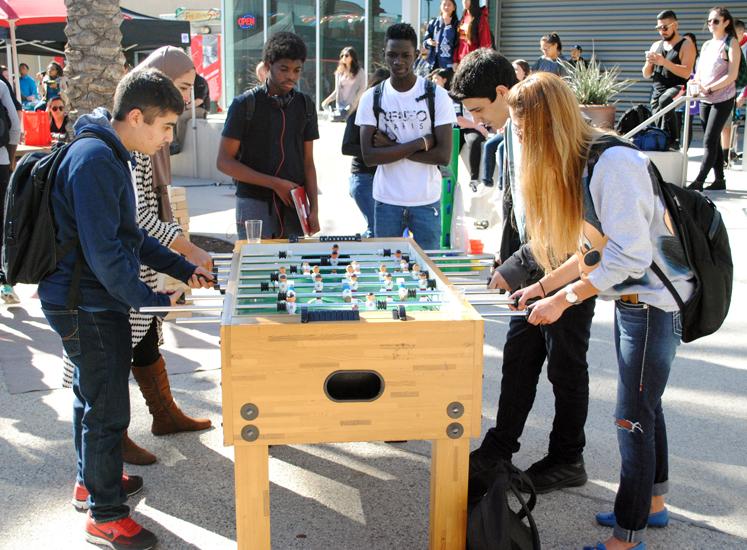Over the past few years, the amount of diversity across California State University campuses has increased significantly regardless of being located in predominantly white communities. Northridge, in particular is one of the most diverse of all 23 CSU campuses yet 56 percent of the surrounding community is white.
Hanso Castillo, for example, discovered his life altered when he attended CSUN not only through means of education, but culturally as well.
Castillo always had a passion for music and while enrolling in classes, he found a club that was about music and performing with a diverse set of students who enjoyed music as well.
“It’s amazing how music can bring together a group of random people with random ethnicities. It’s been great learning about music from different cultural backgrounds and how different we all grew up” Castillo said.
Among the top 5 enrolled CSU systems CSUN is among the top most diverse campuses. As of Fall 2015, the student body is made up 44 percent Latino/a, 23 percent White, 11 percent Asian, 9 percent International, 5 percent African American, 3 percent multi-raced, less than 1 percent Indian, Alaskan Native, Native Hawaiian or Pacific Islander, with 5 percent of the ethnicities not being reported.
According to CSU Office Chancellor Toni Molle, California’s Latino, African-American and Native American students earn more than half of all undergraduate degrees, with nearly one third of all CSU students being first generation college attendees.
“The CSU [system] serves California’s growing underserved communities, offering affordable opportunities to pursue a college degree” Molle said.
CSUN Associated Students Production Coordinator Austin Ysais said the diversity is felt in every corner on campus.
“As a part of the faculty, I can say that not only is our student body diverse, but faculty as well,” he said.”It’s great to continue seeing different ethnicities enrolled in this university. It makes us well rounded.”
According to the CSU College Portrait’s Voluntary System of accountability, of the 917 full-time instructional faculty members, 33 percent of them are persons of color.
Public Health Major, Bernard Fernandez said the cultural diversity on campus has helped him make friends from different backgrounds.
“I’ve made friends with people from different ethnic groups that I wouldn’t have, but just because of the exposure of me being around them.”
Many students have reported similar experiences with 92 percent of seniors reporting that their experiences at this institution contributed to their understanding of people from other backgrounds and 84 percent said they often had serious conversations with students of a different race or ethnicity, according to the CSU college portraits system.
For CTVA Major Cynthia Rojas, the diversity at CSUN depends on the major.
“It is pretty diverse at CSUN but I’d say it is pretty Caucasian at times depending on your major. I’m a CTVA major and what I noticed is that for the most part, there are a lot of Latinos in that major but when I see marketing or engineering its Caucasian or Asian.”
Chicano Studies Department Professor, Stevie Ruiz recognizes the benefits and presence of diversity among CSUN, yet worries impaction will affect the numbers.
“One of the concerns that we have as a department is over time because we’re a service learning institution for the local demographics across the Los Angeles County, will those numbers actually change or actually decrease,” he said.
The diversity among CSUN students in the past five years has gradually gone up as the number of enrolled students increases. Since 2011, CSUN’s total enrolled students has gone from 36,911 students to 41,548 in 2015 according to the Office of Institutional Researches’ annual profile reports.
The percentage of American Indian students stayed the same for all five years, yet the Latino and Latina population increased from 2011’s 34.2 percent to 39.5 in 2015. The white student population decreased from 29.4 in 2011 to 25.9 in 2015. Other significant changes were shown in the international student population increasing from 2011’s 6.7 percent to 2015’s 8.7 percent.
University Student Union student employee Kevin Chau said working on a diverse campus makes him a proud matador.
“As a CSUN student it makes me proud to go to CSUN because of the diversity here, because I get to work with different kinds of people and just like learn from them.”
Along with CSU Northridge, San Diego State University (SDSU) is among the top five highest enrolled CSU systems, it is also the CSU that has won the National Higher Education Excellence in Diversity award for the past three years.
Whereas CSUN’s top enrolled demographic is Latino/Latina, SDSU’s enrollment makeup is predominantly white. The chief of diversity at SDSU, Aaron Bruce, said ethnic diversity is valued at his campus.
“Diversity includes race, gender, sexual orientation, religion, ability, veterans status, nationality, age, class and socioeconomic status” Bruce said. “Most importantly is the overall commitment to diversity and inclusion which supports the quality of life for students.”
Supporting the quality of life is definitely something diversity does for Castillo and his friends. As he walked to his next class he said, “This is like a brotherhood for us, we all have different skin tones, we all look different, and are raised differently and the music brings us together.”
“These guys will be in my life for a long time.” said his friend Quinn Fernandez. “Being with these guys has made my college experience.”
This story was contributed by the students in Professor Hoffman’s investigative class: Laine Wherritt, Grecia Lopez, Danielle Pendleton





